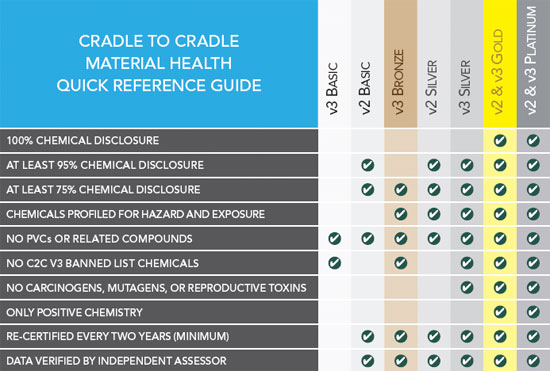Multi-Attribute Certification Pinpoints True Sustainability
As can be seen in the table (see page 142)describing an assessment summary for a Nylon 6 formulation, in some cases, a red flag material can be changed to a moderate risk if there is no chance that the chemical will be an exposure risk to humans or the environment. In this way, Cradle to Cradle encourages product designers to change their thinking. Instead of asking whether a chemical is good or bad, ask if it is being used in the proper way.
Optimization is the process of continuously improving these aspects of a product so it gets a better grade the next time it is assessed. Optimization in the Material Health criteria often requires intensive effort and innovation. Ken Tameling, general manager at Steelcase, cites an example where the company successfully found a product alternative for a particular chair, which is Cradle to Cradle Certified at the Silver level. The company initiated a redesign project to eliminate a small concentration of an identified material of concern.
“The material we sought to replace was an integral ingredient in the product assembly. It was our objective to completely eliminate this material from the chair and our product portfolio. We had two options—search for an acceptable replacement or redesign the chair. After an extensive global search, we discovered that an alternate material did not exist. This type of deep commitment to materials chemistry can lead to cost savings, a cost increase, or cost-neutral. The expertise of our designers, engineers, and procurement people allows us to take on these challenges,” says Tameling. The company's design and engineering team focused on solutions that could be produced utilizing materials that had already been assessed. The resulting material met the desired environmental criteria while doubling the durability of the product at a reduced cost.
While some companies do find alternative ingredients, others cannot yet. Innovation and breakthroughs in green chemistry are needed across industries to truly eliminate chemicals of concern.
 |
For project teams concerned with avoiding chemicals of concern, the Material Health score of a certified product can provide a quick reference for the level of optimization. Chart courtesy of Cradle to Cradle Products Innovation Institute |
Companies pursuing certification must design components of their products as biological or technical nutrients, and for each nutrient, define the path to reutilization, and develop systems to recover used products safely and continuously.
“Closed loop design may seem fairly straightforward. To truly solve for a product's end of life, we have to make it part of the design problem from the beginning. Our designers have to think about how the product can be reused and its materials recovered as 'food' for new products,” says Angela Nahikian, director of global environmental sustainability at Steelcase. One example is the company's signature chair, which was the very first Cradle to Cradle Certified product. “Our developers worked diligently to create a chair that could be disassembled in five minutes with common hand tools with as few parts as possible. During a recent redesign of the chair, we have again made sustainability advancement part of the design problem, including further reducing the number of parts. The cradle to cradle philosophy and the Cradle to Cradle certification is an inherent commitment to ongoing improvement,” says Nahikian.
One industry that has made strides in material reutilization is the carpet industry—and with good reason. Traditional carpet is made from petrochemicals, a nylon surface and a polypropylene backing. U.S. statistics indicate that despite a guaranteed life of between 10 and 25 years, carpeting is replaced on average every seven years. When carpeting wears out, is has traditionally been sent to a landfill. Each year, billions of pounds of old carpet are removed from residential and commercial buildings and sent to landfills across the United States. This disposal of carpet contributes to the loss of landfill space, as well as the loss of valuable resources.









